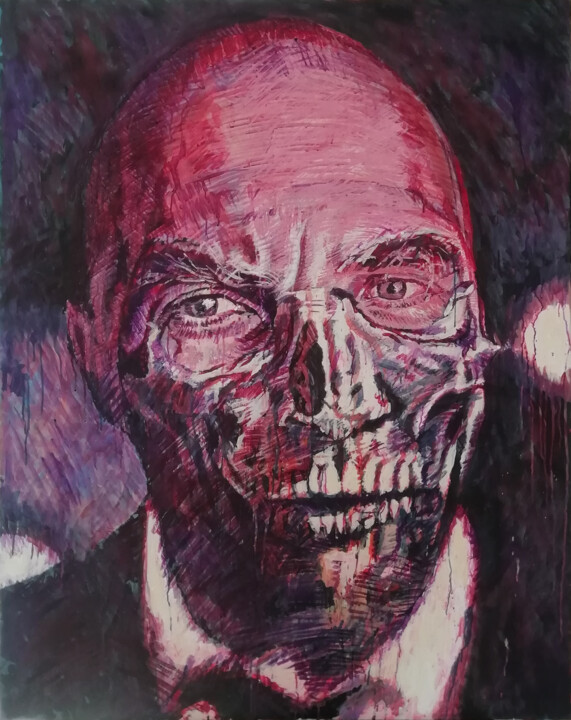



让我们知道您是否想看到这件艺术品的更多照片!
- 工作的背面 / 工作的一面
- 细节 / 签名 / 艺术品的表面或纹理
- 情境中的艺术品, 其他...
I Cаn't Look At My Reflection It Reflects The Future (2021) 绘画 由 Anton Terziev
更多信息
- 包装 (盒子或纸箱包装) 所有的作品都配有优质的承运方,经过严格的包装保护和已投保。
- 监控 跟踪订单,直到包裹交付给买方. 将提供跟踪号码,以便您可以实时跟踪包裹。
- 延迟 全球配送会在3-7天内送达 (估计)
- 不包括海关 价格不包括海关费用。大多数国家/地区对原创艺术品没有进口税,但您可能需要支付减免的增值税。海关费用(如果有)将由海关在抵达时计算,并由承运人单独计费。
更多信息
- 可追踪的在线真品证书 可以通过扫描插图的代码随时在线验证真品证书。
- 认证评级艺术家 专家研究一个艺术家的工作和职业生涯,然后建立一个独立的,可靠的平均价格值。平均价格价值座落在一个价格范围内的某一时期的艺术家。专家们也可能被要求建立一个更精确的估计为特定的工作。
更多信息
使用SSL证书进行100%安全付款 + 3D Secure.
更多信息
“艺术”在纸上打印
这是使用非常高质量的颜料墨水在美术纸上打印并以很高的清晰度打印的过程。它的保存水平非常出色(超过100年),其质量,深度和细微差别超过了在Argentic纸上的经典照片打印。

光面漆
纤维纸除了具有非凡的厚度外,还由不含酸的α-纤维素基底组成,并覆盖有硫酸钡和在印刷过程中具有微孔层吸收作用的颜料。这款纸色为纯白色,不泛黄,特别设计用于抵抗老化。它具有出色的分辨率,呈现深沉的色彩,因此已被世界各大博物馆所采用。
Art Print“美术”-在325 g纤维原纸上的光泽处理。

我们的高端印刷品和复制品
ArtMajeur仅使用从知名造纸商中精选的具有中性pH,耐性和高质量的天然纸!
无论是在色彩控制还是在图形链方面,我们的主打印机一直都在关注。我们对质量的高要求是ArtMajeur裱框艺术品的主要资产。
关于艺术家! 您可以帮助艺术家活出自己的生活。 每当您购买印刷品时,他们都会获得使用费。
关于我们的优良打印购买许可证以将此图像用于您的网站、通信或销售衍生产品。
Usage: 网络许可证
| 1189 px | ||

|
1500 px |
| 文件尺寸 (px) | 1189x1500 |
| 全球使用 | 是 |
| 用于多点支持 | 是 |
| 用于任何类型的媒体 | 是 |
| 转售权 | 没有 |
| 最大打印数量 | 0 (Zero) |
| 拟出售的产品 | 没有 |
购买后立即下载
此图片可以用许可证下载: 您可以随时下载它们。
限制
所有在ArtMajeur的图像是由艺术家创作的原创作品,所有权利是严格保留的。获得许可证后有权根据相应条款使用或利用图像。可以进行微小的修改,如重构或重新聚焦图像,使其完全符合新项目要求,但是,禁止进行任何可能损害原始作品的修改。其完整性(形状修改,扭曲,切割,改变颜色,添加元素等),除非事先从艺术家获得书面授权。
定制许可证
如果您的用途不在我们的标准许可证范围内,请联系我们获取定制许可证。
艺术图片银行-
原创艺术品 (One Of A Kind)
绘画,
油
在帆布上
- 外形尺寸 高度 51.2in, 宽度 39.4in
- 艺术品状况 艺术品完好无损
- 是否含画框 此作品未装裱
- 分类 画作 低于US$5,000 形象艺术 男士肖像
Terziev’s painting stands firmly within the long lineage of *memento mori* artworks—Latin for “remember you must die.” This genre, prevalent in Medieval and Baroque Europe, was designed to remind viewers of mortality and the transient nature of earthly existence. In Terziev’s interpretation, the *memento mori* element is signaled through the superimposed skull, a visual nod to the classical skull symbolism in vanitas still lifes and portraiture.
Self-portraits historically function as both expressions of personal identity and meditations on the artist’s role in society. Here, the act of self-representation is inseparable from the symbolism of the skull, suggesting a dual identity: one rooted in the tangible present (the artist’s living face) and the other pointing toward the inevitability of human decay (the exposed skull).
Terziev’s composition seamlessly integrates the living visage with the skull. The painting’s surface suggests vigorous, textural brushwork—visible striations and directional strokes that build an almost sculptural quality. This technique heightens the sense of tension between the face and its macabre overlay, reflecting the psychological and physical layers of human existence.
Dominated by deep reds, purples, and bruised pinks, the color choices imbue the work with an otherworldly aura. Red often symbolizes both vitality and violence—life and the fragility that can suddenly extinguish it. The interplay of purples and darker hues conjures an atmosphere of dusk, a liminal time suggestive of transition and reflection.
Subtle highlights across the brow ridge and cheekbones create a chiaroscuro effect, referencing the dramatic light/dark contrasts used by Baroque masters like Caravaggio. However, Terziev’s approach feels more contemporary and expressive, favoring emotional resonance over strict realism. This tension between classical technique and modern expression intensifies the painting’s psychological presence.
The title, *I Cаn’t Look At My Reflection, It Reflects The Future*, offers a philosophical riddle. Traditionally, a mirror is a symbol of self-awareness and vanity; here, it becomes a conduit to contemplate mortality. By refusing to look at one’s reflection, the subject metaphorically denies confronting the inescapable reality of aging and death, even as the image insists on it.
While overtly personal—being a self-portrait—the painting’s imagery reaches beyond individual biography. The half-skeletal face reminds viewers that everyone grapples with the passage of time, the erosion of youth, and the unpredictability of the future. Thus, Terziev’s self-examination also becomes a universal meditation on life’s fragility.
The bold, almost raw application of color and line suggests affinities with Expressionist movements of the early 20th century, such as those pioneered by Egon Schiele or Francis Bacon’s psychologically charged portraits. Terziev’s painting, like theirs, seeks to expose the inner workings of the psyche rather than to present a purely naturalistic representation.
In contemporary art, memento mori works often intersect with postmodern questioning of identity. Terziev’s self-portrait resonates with these explorations, positioning the body (and especially the face) as a site where existential anxieties manifest. His focus on the skull, painted in an almost surgical clarity, also recalls the medical imagery sometimes employed by modern and contemporary artists to explore corporeality and mortality.
The painting’s visceral impact stems from its fusion of two realities: the immediate present (the living face) and the stark inevitability of death (the skull). The technique of partial superimposition—where the skull and face seem to bleed into one another—amplifies the work’s unsettling power, inviting a prolonged and introspective gaze.
By invoking the viewer’s own sense of self-awareness, *I Cаn’t Look At My Reflection, It Reflects The Future* serves as a contemporary *memento mori*, prompting reflection on our shared fate. It extends beyond personal confession to a broader statement about the human condition, forging a connection that transcends time and place.
Anton Terziev’s *I Cаn’t Look At My Reflection, It Reflects The Future* is a compelling continuation of a centuries-old artistic tradition that addresses life’s temporality and the inescapable presence of death. Through expressive brushwork, a brooding color palette, and a dramatic juxtaposition of flesh and bone, Terziev reimagines the *memento mori* for our age—merging personal introspection with a universal reminder of life’s fragility. It is a painting that demands engagement, daring viewers to confront the ultimate unknown that lies within and ahead of us all.
Fotomaterial used: 007 Sean Connery Skull Portrait By Joedunnz
相关主题
安东·泰尔齐耶夫 (Anton Terziev) 是一位当代保加利亚艺术家,他是一位运用尖锐讽刺作为艺术工具来处理各种当代主题的大师。他的作品的特点是对图像的深刻运用,传达了鲜明而批判性的意象。在他的艺术作品中,安东巧妙地将赌注、技巧和讲故事的元素编织在一起,产生了具象的当代艺术,其中带有社会评论、幽默和关于艺术家状况的信息。
安东·泰尔齐耶夫 (Anton Terziev) 从两个不同的来源汲取灵感。首先,他的艺术往往源于现实生活中的事件,以激发他的创作过程的方式在他周围展开。其次,他的想象力在他的作品中发挥着关键作用,使他能够创作出生动且发人深省的图像。他的每件作品都装饰着从电影和书籍中提取的流行文化的微妙元素。每件作品中都蕴含着一种叙事,一种元文本,既丰富了观众的体验,又不会让他们不知所措,因为安东相信,好的艺术可以温和而有效地进行交流。
安东作品的独特之处在于他坚定不移地致力于给观众留下一种无限的惊奇感。他的作品邀请观众与艺术进行对话,鼓励他们解释、质疑和探索他所呈现的叙事。为他的作品选择完美的标题是一个挑战,他经常从文学、电影或音乐中汲取灵感来应对。
安东·泰尔齐耶夫的画家生涯与他的作家身份错综复杂地交织在一起。他的想法以绘画和艺术品的形式得以体现,体现了他多样化的才能。除了绘画之外,他还通过表演、电影制作和设计将他的艺术愿景变为现实,展示了多方面的创意表达方式。









